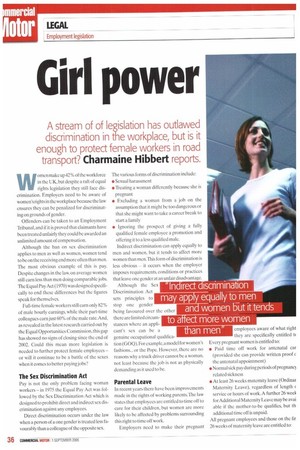Girl power
Page 36

Page 37

If you've noticed an error in this article please click here to report it so we can fix it.
A stream of of legislation has outlawed discrimination in the workplace, but is it enough to protect female workers in road
transport? Charmaine Hibbert reports.
Women make up 42% of the workforce in the UK, but despite a raft of equal rights legislation they still face discrimination. Employers need to be aware of women's rights in the workplace because the law ensures they can be penalized for discriminating on grounds of gender.
Offenders can be taken to an Employment Tribunal, and if it is proved that claimants have been treated unfairly they could be awarded an unlimited amount of compensation.
Although the ban on sex discrimination applies to men as well as women, women tend to be on the receiving end more often than men. The most obvious example of this is pay. Despite changes in the law, on average women still earn less than men doing comparable jobs. The Equal Pay Act (1970) was designed specifically to end these differences but the figures speak for themselves.
Full-time female workers still earn only 82% of male hourly earnings, while their part-time colleagues earn just 60% of the male rate. And, as revealed in the latest research carried out by the Equal Opportunities Commission, this gap has showed no signs of closing since the end of 2002. Could this mean more legislation is needed to further protect female employees — or will it continue to be a battle of the sexes when it comes to better paying jobs?
The Sex Discrimination Act
Pay is not the only problem facing woman workers — in 1975 the Equal Pay Act was followed by the Sex Discrimination Act which is designed to prohibit direct and indirect sex discrimination against any employees.
Direct discrimination occurs under the law when a person of a one gender is treated less favourably than a colleague of the opposite sex. The various forms of discrimination include: • Sexual harassment • Treating a woman differently because she is pregnant • Excluding a woman from a job on the assumption that it might be too dangerous or that she might want to take a career break to start a family • Ignoring the prospect of giving a fully qualified female employee a promotion and offering it to a less qualified male.
Indirect discrimination can apply equally to men and women, but it tends to affect more women than men. This form of discrimination is less obvious — it occurs when the employer imposes requirements, conditions or practices that leave one gender at an unfair disadvantage.
Although the Sex Discrimination Act sets principles to stop one gender being favoured over the other there are limited circumstances where an applicant's sex can be a genuine occupational qualification (G0Q).For exam ple, a model for women's fashions.., or the Pope. However, there are no reasons why a truck driver cannot be a woman, not least because the job is not as physically demanding as it used to be. 41
Parental Leave
In recent years there have been improvements made in the rights of working parents. The law states that employees are entitled to time off to care for their children, but women are more likely to be affected by problems surrounding this right to time off work.
Employers need to make their pregnant employees aware of what right they are specifically entitled tr Every pregnant women is entitled to: • Paid time off work for antenatal car (provided she can provide written proof c the antenatal appointment) • Normal sick pay during periods of pregnancy related sickness • At least 26 weeks maternity leave (Ordinar Maternity Leave), regardless of length service or hours of work. A further 26 weep for Additional Maternity Leave may be avai able if the mother-to-be qualifies, but th additional time off is unpaid.
All pregnant employees and those on the fir 26 weeks of maternity leave are entitled to: • Not suffer loss, be dismissed or made redundant for any reasons connected with pregnancy, child birt h or maternity leave • Their normal contractual benefits, (eg accumulation of holiday entitlement) • Be notified of job vacancies while on leave • Return to the same job, but after additional maternity leave a woman may not be able to return to the same job :in some cases,an alternative job could be offered.
Flexible working Following the introduction of new employment rights in April 2003, some 3.8 million parents are now entitled to have their requests for flexible working seriously considered by employers. An employer cannot just say "No"— he must have a reasonable argument as to why flexible working is not an option for the employee concerned. It is important to under stand that although employees have the right to ask for flexible working hours, employers can refuse flexible working if they have good business reasons to do so. •




































































































































































































